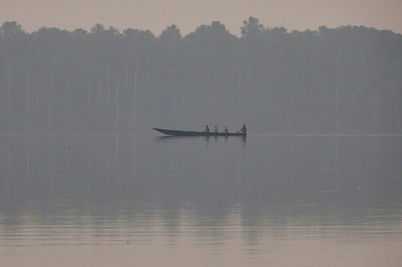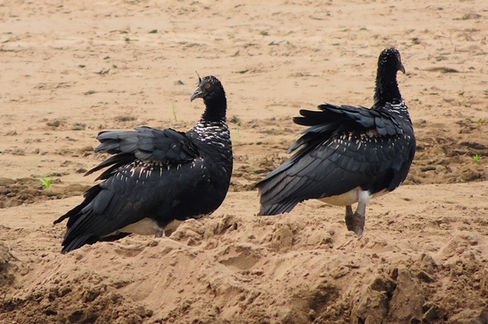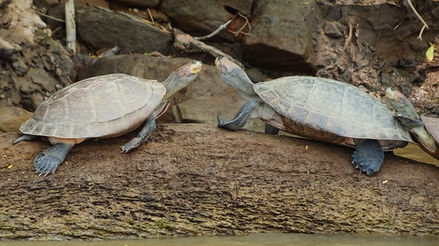
Tambopata National Reserve, Amazon
Peru
The gateway to Tambopata National Reserve, a protected area of the Amazon Rainforest, is the town of Puerto Maldonado, a dusty, humid and blisteringly hot town where there’s not a whole lot going on for tourists. After spending the last few months at elevation, coming back down to sea level and being smacked with 39°C heat was a shock to the system. We had arrived on an overnight bus at 7.30 a.m., and other than eat breakfast then lunch, there was nothing else to do until the other 2 people in our group arrived in the early afternoon. Once we had lost a few litres of sweat and drank more fruit juice than in the entire time we had been travelling, we finally departed for our tour at 2 p.m.
A 30-minute longtail boat trip took us downstream, the breeze a welcome relief. The water was murky brown and a smoke haze lingered in the air, so there wasn't much to see on this stretch (apparently the smoke, due to burning off in the Bolivian Amazon, is never this bad. It had impacted our experience at Machu Picchu and was now affecting our Amazon adventure). From the landing point it was a 3 km walk through a palm-filled jungle, with macaws squawking from the treetops. On the way we were lucky enough to spot baby saddleback tamarin monkeys (too fast for the camera) and a large red howler monkey (mostly hidden behind foliage). Our guide, Fredy, pointed out a few plants and birds, but we were dying in the heat and just wanted to rest.
At the end of the trail, we stepped aboard a canoe and were rowed by Fredy down a narrow, overgrown channel that led out to Sandoval Lake. With the smog in the air, the sun looked like a fiery ball glowing in the sky, giving everything an orange-brown tinge. It was incredibly quiet, peaceful and, despite being just a large flat lake, quite beautiful. Birds flew overhead and large butterflies flitted around us.
The primary reason I wanted to visit Lake Sandoval was to spot the Giant River Otters, the kings of the water. They are known to kill everything, including caimans and anacondas. Given there was only one family of 5 otters living in this expansive lake, the chances of seeing them were slim. But luck was on our side, and it wasn't long before we spotted their heads poking out of the water at random intervals in a meerkat-like fashion. Our canoe followed them for a while as they continually swam away from us. Eventually they reached the mangroves on the side of the lake, scratched themselves for a while, then disappeared into the forest. Even though we didn't get a close-up view, we felt very fortunate to observe them for as long as we did.
As we pulled up to our lodge of the shore of the lake, we noticed a large troop of squirrel monkeys playing in the trees above us. Occasionally pieces of plant matter would fall down close to our boat, and we wondered if the monkeys were deliberately trying to hit us. Our accommodation consisted of rustic wooden huts with fly screens for windows, limited electricity and basic amenities. The cold showers weren't as bad as we expected.
Once it was dark, we commenced our night boat ride along the edge of the lake. Before we had even reached the canoe, Fredy pointed out a mammoth hairy tarantula sitting just outside the dining room. When Danny leant in to take a photo it quickly scuttled away, giving Danny the fright of his life. On the almost pitch black lake we were surrounded by so-called fishing bats, repeatedly swooping close by. Our main aim was to spot caimans, and our torches repeatedly picked up the red glint in their eyes as they sat within the mangroves. Fredy pulled up close to a couple of them, their watchful eyes staring at us as they remained perfectly still. Occasionally a small fish would jump out of water, and as quick as a flash the caiman would snatch at it with its mouth. Right after informing us that some caimans grow up to 6 metres long, Fredy declared it was perfectly safe to go swimming here in the morning. No thanks.

At 6 a.m. we departed on our morning wildlife cruise, canoeing around the lake to see who was awake. It was extremely tranquil on the water, with no breeze to speak of and only the sounds of birds in the air. Fredy named them as they flew by or as their call reached us: macaws, parrots, herons, ibises, kingfishers and a species the locals call stinkbirds, aka hoatzins (apparently they smell like poo, so no one wants to go near them). He was clearly knowledgeable and passionate about his birds, but what we were really interested in were the otters.
Fifteen minutes later Fredy rapidly rowed us over to the other side of the lake, where 2 other canoes had already arrived. The otters were right where we left them last night, in the mangroves by the shore. We stared intently as they hunted for fish, fought over their spoils then ate their breakfast in peace. After this they cleaned themselves carefully before having a brief standoff with a caiman (the caiman survived). Again they were almost impossible to capture with a camera, as they always popped out of the water in a different place to what you expected. They did kindly lounge on a rock for a short stint, but the rocking of the boat didn't help my photography skills. It was a memorable experience.
Once we had eaten our breakfast (no fish for us), we made the canoe/hike/motorised boat return trip to Puerto Maldonado. Along the way the screech of macaws filled the air, while howler monkeys hid at the tops of the trees. Back at the main office, we collected 5 other couples then settled in for the 3-hour boat ride upstream, where our much more upscale lodge awaited us on the Tambopata River.
I can't say the river scenery was picturesque. It was wide and dirt brown, and the local gold miners operating loud machinery in the middle of the river didn't give off a tranquil Amazon vibe. As it was the dry season the water was extremely shallow, but somehow the driver navigated us through the unseen canals that existed below the surface. For the most part it was relaxing and we cherished the cool breeze, but there was little wildlife to be seen in the heat of the day. We slowed down momentarily for a pair of horn screamers (birds that have a horn on their head and make a sound like a donkey), a lone heron, a series of yellow-spotted Amazon river turtles sitting on a log, and a family of 6 capybaras, famous for being the largest and possibly the cutest rodents in the world.
As soon as we arrived, we sat down to a buffet lunch before having the rest of the afternoon to relax (which for us meant hitting the bar). In the late afternoon, we started out on a wildlife walk in the jungle surrounding the property. The air was filled with the sound of bugs chirping and monkeys rustling the branches above our heads, while fireflies danced around us. Various plants and their uses were pointed out by Fredy, such as a bark that smelled like garlic and a white sap that could kill parasites. Spiders and insects abounded, including bullet ants (the biggest ants in the world), millipedes, grasshoppers, stick insects, dung beetles, butterflies and a large nest full of wasps. Two gigantic tarantulas were spotted, and although they disappeared inside their holes as we neared, Fredy managed to entice them out again for our cameras. The highlight was a distant sighting of a tapir, an notoriously difficult mammal to see in the wild, but this one was standing only 20 metres away. It quickly vanished into the trees as we tried to approach. In the end it was a fairly successful hike and much more interesting than our Amazon night hike in Ecuador, where all we saw were thousands of ants.

3.30 a.m. was the wake-up time to visit the Choncho clay lick, an early morning feeding site for parrots and macaws. By 4 a.m. we were in the boat and driving upriver, for some unknown reason without any lights to guide us. It was hard to believe the driver could navigate through the virtually jet black conditions, with only the occasional torch light to help him through the tricky bits. We all huddled under blankets against the chilly morning air, while the guides used poles and oars to help push the boat through the low water sections.
At 6 a.m. we disembarked and walked along the shore to our viewing area, far across the river from the clay lick (we were fortunate it wasn't wet season, otherwise we would have been further up the bank). Hundreds of birds were already out in force, perched in the trees or on the clay wall. There was very little to see with the naked eye, and even binoculars provided minimal details. Our guides were prepared for this and set up a telescope for each group, focusing in on a different bird species every few minutes. Fredy announced he was the expert photo taker, so we each handed him our phones in turn to capture images through the telescope. The birds were stunning, particularly the larger macaws, although the smoke haze dampened their colours slightly. We watched and listened to the spectacle for an hour and a half before walking down to our breakfast site on the edge of the river. If given the choice, I would have happily stayed much longer.
It was a 2-hour boat ride back to the lodge, spotting a couple of timid capybaras who sauntered off soon as we drew near. Then it was 2 hours of ‘relaxation’, lunch, followed by another hour of 'relaxation'. I'm not used to doing nothing, so it wasn't overly relaxing for me. I wished there had been something to fill in the time other than doing laps up and down the boardwalk running through the property. As most animals rest in the heat of the day, there would have been little to see even if we had gone exploring.
In the afternoon we piled back into the boat and zipped downstream towards Tres Chimbadas Lake. On the way we stopped to watch an entire family of capybaras cooling off in the water, who didn't mind that we were only a few metres away. We also located a solitary deer, an animal I wasn't expecting to see in the Amazon.
From the drop-off point we hiked for 30 minutes through a dense, palm-filled jungle, which was uneventful until a small green snake whipped past us all. At the end was the perfectly still, misty Tres Chimbadas Lake, smaller than Sandoval but just as peaceful. We were the only people there, floating along on a rickety catamaran.
Stinkbirds were spotted again, who were seemingly terrified of us and immediately flew off (if they really do smell like manure, then the further away the better). A troop of red howler monkeys silently ran through the trees, too early in the day to make their famous bellowing call. Much to our surprise, we found the one and only family of otters living in this lake. Six of them were sitting in the shallow water, annoyingly behind a large branch. Like at Sandoval, this was where most of our attention was focused.
The next part I was not a fan of: fishing for piranhas. I turned the other way while the other groups sunk their lines into the water, with moderate success. I'm not sure how the locals can be so protective of all the other species that live in the Amazon, yet believe that killing fish for fun is okay, even if they are released afterwards. Our activities attracted a long black caiman, who happily ate the piranhas that were tossed back in the water.
We made the return hike in the dark with fireflies glittering beside us. In the boat on the way back to our lodge, one guide pointed out a tiny spectacled caiman on the shore, a species we hadn’t seen before. It cautiously crawled towards the water and disappeared under the surface as we came closer. A larger black caiman was also identified a little later. Once back at the lodge, it was drinks, dinner and much needed sleep after our early wake up call.


There was nothing on the itinerary for today other than leaving Tambopata behind and returning to civilisation. I had woken early due to the intense sound of birds and insects around us, so I decided to take a short stroll on the trails in the surrounding jungle (according to the rules we weren't supposed to do this by ourselves, but I was always in sight of the lodge, and a few of us were a bit annoyed that they couldn't have provided a pre-breakfast hike for us). It wasn't long before I saw troops of monkeys swinging high through the trees, moving lightning fast and making death-defying leaps between branches. At first they were the darker tamarin monkeys, and later I stumbled upon the lighter-coloured squirrel monkeys. I also glimpsed an agouti on the path, who shot off as soon as it detected my presence. Quite productive for a 30-minute walk.
After breakfast we jumped on the boat for the last time and drove downstream to Puerto Maldonado, where we sat through the muggy, suffocating heat for 6 hours before boarding our flight to a much more pleasant climate on the other side of the country.







































































